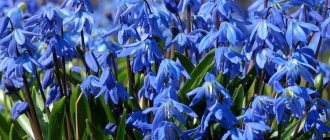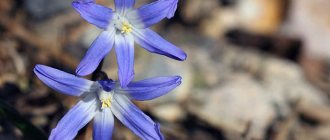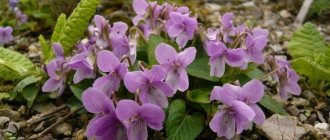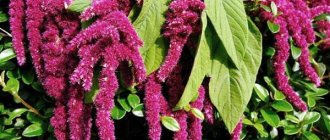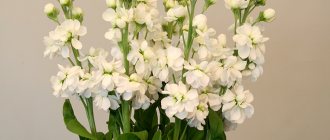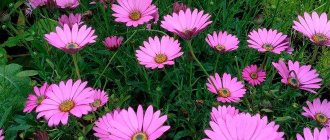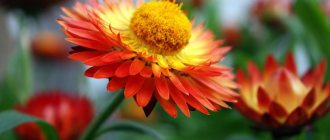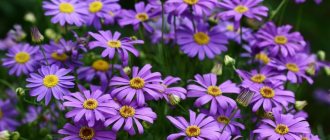Muscari flowers are compact miniature plants that can please the eye in early spring, when other crops are still dormant or have just begun to awaken after winter. The flower looks especially impressive in large group plantings, creating the impression of a bright spot. Muscari is also suitable for forcing if favorable conditions are created.
Mouse hyacinth is an excellent honey plant
Description of muscari flowers
The culture belongs to the Hyacinth family. Under natural conditions it grows in the Caucasus, Southern Europe, the Mediterranean, Crimea, as well as Central and Asia Minor, preferring to grow in mountainous areas. The flower received its name for its pleasant smell, which resembles musk. But it is also called viper onion.
Every spring, the mouse hyacinth initially develops a basal rosette of straight leaves, which consists of 7-9 pieces. Its plates reach 18 cm, their surface is matte, without a pattern.
Important! In some flower varieties, leaves can grow back in the fall and remain green over the winter.
What does a muscari bulb look like?
The underground part of mouse hyacinth is represented by a round, ovoid bulb. Its length reaches 2.5-3 cm, and its diameter does not exceed 2 cm. On top it is covered with light-colored scales. During the period of active growth, a bunch of roots appears from the bottom.
Important! Mouse hyacinth is a short-growing crop, since after a short period of growth, its bulb enters a dormant period.
When do muscari bloom?
The flowering period of muscari depends on weather conditions and the characteristics of the variety. This can happen at the end of March and until June. The flowering period of mouse hyacinth is three to four weeks. At this time, a fleshy peduncle appears from the center of the leaf rosette, the height of which reaches 10-15 cm. It has a racemose shape, many small flowers are formed on it, tightly pressed to each other. In their shape, the buds of mouse hyacinth resemble a lily of the valley, since they have petals fused at the base. In the photo you can see a close-up of muscari flowers, where you can clearly see how their edges are strongly bent and divided into six lobes.
When the buds open, an intense pleasant smell is felt, which intensifies in the evening and after rain. The color of muscari flowers, according to the description of the plant, can be white, purple, blue, indigo, and in rare cases yellow. Sometimes there is a contrasting border along the edge.
After pollination of flowers, mouse hyacinth produces fruit-boxes with fleshy walls of a heart-shaped or spherical shape. Inside them are small dark brown seeds.
The inflorescence of mouse hyacinth blooms from bottom to top
Is muscari poisonous or not?
The perennial belongs to the category of poisonous crops. Therefore, all work with this flower should be carried out with gloves. In people with hypersensitivity, contact with the bulbs and its aerial parts can cause skin dermatitis.
Muscari is a perennial or annual plant
Mouse hyacinth is a perennial crop. The lifespan of one bulb is five to six years. After this, she dies, leaving offspring.
Beautiful Muscari plant
Mouse Hyacinth is a herbaceous perennial .
Other names of the plant: Muscari, Viper and Snake Onion, Vine plant. Scientific names: Eubotrys and Botryanthus. Latin name: Muscari from the word “musk”. After a series of successful works, this name was given to the plant by the botanist F. Miller.
This representative of the flora belongs to the flowering division, Monocotyledones class, families Hyacinthaceae and Asparagaceae.
South Africa and Asia are considered the birthplace of mouse hyacinth. More than 65% of all subspecies grow in the Mediterranean regions.
Currently, the plant is bred in Australia and the USA. The main growth occurs in sunny forest glades. The plant loves thickets of bushes and trees, slopes with tall grass. Hyacinth can be found in the mountains of the Russian Federation and the steppe zone in open areas.
The flower is not afraid of wind , so it can grow over 3000 meters above sea level. For professional gardeners, the plant grows in summer cottages and gardens. With good care it can grow in long containers on loggias, balconies and greenhouses.
Types and varieties of muscari
There are about sixty species of mouse hyacinth found in nature. Also, thanks to selection, it was possible to obtain new modern hybrid forms of this bulbous crop. Therefore, you should familiarize yourself with the photos and names of the most popular varieties of muscari.
Important! Several flower stalks may appear from one bulb.
Muscari Armenian
This species is called Colchian. The flower grows in the conditions of Transcaucasia and Turkey. Armenian mouse hyacinth (Muscari armeniacum) is characterized by a multi-flowered, almost spherical inflorescence. Its basal rosette consists of 3-7 plates. The species overwinters without leaves. Blooms in late spring.
The Armenian species has upper buds of a lighter shade
Muscari Armenian Fantasy Creation
Muscari terry Fantasy Creation is characterized by a greenish tint of the petals, which later becomes deep blue. The height of the flower reaches 20 cm. The basal rosette consists of five to seven leaves. The flowering period begins in mid-May.
Fantasy Creation does not require shelter for the winter
Muscari Pink Sunrise
This variety has flowers of a soft pink hue. Muscari Pink Sunrise does not exceed 15 cm in height. The shape of the inflorescences is pyramidal. They appear at the end of May.
Pink Sunrise is suitable for border plantings
Pink Surprise
This variety has soft pink flowers. Muscari Pink Surprise has a height of no more than 20 cm. The flowering period begins at the end of April and lasts three weeks.
The diameter of Pink Surprise flowers is 2 cm
Peppermint
The height of the Peppermint muscari flower is about 20 cm. The variety blooms in the second half of May. The basal rosette of leaves consists of 5-7 pieces. The shade of the petals is pale blue. The leaves are dark green in color.
Peppermint gives off a pleasant scent when the flowers open.
Muscari grapevine
The flowers of this species are collected in racemose inflorescences. The number of leaves in a rosette is 2-6 pieces. The height of the bare peduncle of the mouse hyacinth (Muscari botryoides) reaches 12 cm. The petals are blue with a slight purple tint and a white contrasting edge.
Flowers of the cluster-shaped species bloom in early May
Muscari grapevine Album
A special feature of the variety is the white tint of the petals with a beige tint. Flowers bloom at the end of April. Album's rosette of leaves consists of 3-5 pieces. Flower height 15 cm.
The album looks good in group plantings
Muscari latifolia
The culture is thermophilic. Mouse hyacinth (Muscari latifolium) has a full peduncle, consisting of one hundred buds. The shade of the petals is dark purple. Muscari latifolium (photo below) blooms in April. Two or three flower stalks emerge from one bulb.
Broadleaf viper onion has cylindrical peduncles 6 cm long
Important! Mouse hyacinth broadleaf can freeze slightly in snowless winters, so it requires shelter.
Muscari crested
During the flowering period, the height of a plant of this species can reach 70 cm. The basal rosette consists of belt-shaped leaves. The inflorescence is loose, racemose, containing 40-100 buds. The color of the petals of the crested mouse hyacinth (Muscari comosum) is light brown with a cream edge. The bulb has the shape of a wide cone.
Mouse crested hyacinth produces many leaves and flowers in nutritious soil
Plumosum
This variety of mouse hyacinth is distinguished by a lilac-violet hue of the petals. The flowers are thread-like, which makes it stand out from other types of crops; the height is 20 cm. The basal rosette consists of 5-7 leaves of a rich green color. Muscari Plumosum is demanding in terms of planting and care. Flowers bloom in mid-May.
Important! Plumosum is unstable in the middle zone and freezes out in snowless winters.
Plumosum forms two or three peduncles from one bulb
Muscari pale
This species is one of the rarest and smallest. Pale mouse hyacinth (Muscari pallens) has an ovoid bulb, the length of which is 1.5-3 cm. The leaf rosette consists of 2-6 pieces, the length of the plates is about 18-20 cm. The inflorescences consist of 30-40 buds. The color of the petals is pale blue with white teeth along the edge. Flowering occurs at the end of May.
The throat of flowers in the pale species is not constricted, like in others
White Beauty
This variety of mouse hyacinth is distinguished by a pale pink shade of petals, and they are lighter in the upper part of the inflorescence and darker at the bottom. The height of this species reaches 25 cm. The basal rosette of the White Beauty flower consists of three or four plates of a rich green hue.
The length of the inflorescences of the mouse hyacinth variety White Beauty is 5 cm
Muscari ambrosia
In some sources, this type of culture can be found under the name Muscarimia mouse. Ambrosia hyacinth (Muscari ambrosiacum) is characterized by racemose inflorescences, which consist of 20-50 buds. The color of the petals of this species changes as the buds open. Blooms in mid-April. Initially the color is purple, and then lightens, becomes greenish and finally acquires a creamy tint.
The ragweed species has sterile flowers with a purple tint.
Muscari neglected
A rare species of mouse hyacinth, which is listed in the Red Book. The height of the flower reaches 20 cm. The leaves of the neglected mouse hyacinth (Muscari neglectum) are belt-shaped, dark green in color. The length of the peduncles does not exceed 5 cm; they consist of 20-30 buds.
Neglected mouse hyacinth is found mainly in forest-steppe and steppe zones
Muscari azure
In some sources, this species is found as azure or muscari Azureum. The plant reaches a height of 15-20 cm. And the inflorescence size is about 8 cm. Each of them contains 30-60 buds. The rules for planting and caring for the azure muscari flower are the same as for other species. The petals at the top of the inflorescence are lighter than at the bottom.
The azure species blooms in late April - early May
Muscari Oshe
This species has bulbs no more than 1.7-2 cm. The basal rosette of leaves in the Oshe mouse hyacinth (Muscari aucheri) consists of two or three leaves. The bare peduncle reaches a height of 10-15 cm. This type of muscari (photo below) has blue buds with pale teeth along the edge. The perianth is oblong.
Important! Oshe does not tolerate prolonged stagnation of moisture in the soil.
Oshe mouse hyacinth overwinters without leaves
Blue Magic
A modern variety that is highly decorative. At the top of the sky-blue inflorescences there is a white tuft that attracts the eye. Blue Magic blooms buds at the end of April, this period lasts about four weeks. The height of the bushes reaches 20 cm.
Blue Magic easily adapts to any climatic conditions
Muscari large-fruited
The large-fruited mouse hyacinth flower (Muscari macrocarpum) is a heat-loving crop, so in temperate climates it can only be grown in containers. The buds are yellow, fragrant.
Important! The bulb of this type of crop dies at temperatures below +5 degrees.
The flowers of the large-fruited species open in May
Golden Fragrance
This variety of muscari is characterized by a purple hue of buds, which subsequently acquires a bright yellow color. The height of the bushes of Golden Fragrance muscari reaches 30 cm. The leaves are up to 20 cm long, their width is 2 cm.
Mouse hyacinth Golden Fragrance is suitable for forcing
Muscari vulgare
A low-growing species, the height of the bushes barely reaches 12 cm. In nature, the common mouse hyacinth (Muscari botryoides) can be found in the Caucasus, as well as in Southern and Western Europe. The leaves of the plant are erect, linear, dark green in color.
Important! Common mouse hyacinth is considered the most fragrant type of crop.
The color of the petals in the common species is blue, light blue, or less often white.
Muscari Liriope
A special feature of this variety is the rhizomatous underground part. In most cases, gardeners plant and care for Muscari Liriope at home, growing it in pots. The leaves are xiphoid, hard, dark green with longitudinal light stripes. Flowers bloom in autumn. The color of the petals is purple or white.
The height of Liriope bushes reaches 60 cm
Muscari is nice
A wild species of mouse hyacinth that is not used in gardening. Pretty Muscari (Muscari pulchellum) has small bushes, the height of which does not exceed 12 cm. Pretty Muscari (photo below) has blue flowers. The diameter of the buds when opened does not exceed 0.7 cm.
The perianth of a pretty species is spherical in shape, slightly narrowed at the throat
Description
Muscari or viper onion (in Latin muscari), is a perennial plant. It received its name in honor of the botanist Miller, who assured that the flower has a musky aroma. The genus Muscari includes about 50 species. The plant grows from 4 to 30 centimeters. The bulb resembles the shape of an egg, with a diameter of 2.5 cm.
Interesting! In Turkey, the flower is called “mushi-rumi”, which means “you will receive everything I can give you.”
When spring comes, narrow, dark green leaves and flower stalks appear on the stem. The inflorescences are very dense, up to eight centimeters long, and look like a brush. The flowers are blue or purple, and there are white and yellow varieties. During the flowering period, they fill the air with a spicy aroma. In nature it can be found in northern Africa, as well as in western Asia, in European countries, in Russia it grows in the Krasnodar region. Some of the Hyacinth family can be seen in North America and Australia. The mouse flower adorns forest glades, steppes, mountain slopes and hills.
Interesting! Many people are interested in the question: is viper onion a cultivated plant or a wild plant? The flower grows well both in the wild and in summer cottages.
How do muscari reproduce?
To obtain new flower seedlings, you can use seeds and dividing the bulb. The first method is very labor-intensive and time-consuming, so flower growers rarely resort to it. Muscari seeds remain fresh for only 1 year, so sowing should not be delayed.
Planting should be carried out immediately after harvesting in the fall in open ground to a depth of 1-2 cm. During the winter, natural stratification of the seeds occurs, and seedlings appear in early spring. The bulbs form within five months. They bloom in the third year after planting.
Important! When grown from seeds, the species properties of mouse hyacinth are not preserved.
The easiest way to propagate a flower is to separate the daughter bulbs. This should be done every three to four years. It should be planted in August - September at a distance of 10-15 cm and a depth of 4-6 cm.
Muscari flower - description
Muscari are small-bulbous plants up to 60 cm high with 2-7 fleshy linear basal leaves, reaching a length of 10-17 cm. The bulbs of muscari are ovoid, up to 2 cm in size. The leafless peduncle bears a multi-flowered raceme of fragrant white, blue, purple or blue flowers up to 6 mm long and up to 4 mm in diameter, located on short stalks; the perianth of the flowers is tubular, cylindrical or barrel-shaped, consisting of 6 fused leaflets with edges bent outward; the upper flowers in the raceme are sterile. The muscari fruit is a winged, angular, three-lobed capsule with rounded black seeds that remain viable throughout the year.
When to plant muscari bulbs in open ground
Muscari can be planted in a permanent place in autumn and spring, depending on the region. Each of these methods has certain features that need to be taken into account.
When to plant muscari in the fall
This planting date is preferable, as it allows the plant to bloom next spring. It is recommended to carry out the procedure at the end of August or September, depending on the conditions of the growing region.
Planting muscari in spring
During this period of the year, it is recommended to transplant muscari to another place of heavily overgrown bushes. To do this, you need to dig up the mother flower, divide it into daughter bulbs and immediately plant it in a permanent place.
When planted in spring, viper onions bloom only after a year
Diseases and pests of muscari
Muscari pests and their control
Since insects appear in the garden later than the muscari blooms, they do not have time to do much harm to this plant. But voles can harm muscari even in winter, gnawing and dragging the bulbs into their homes. Garlic planted around the flower garden repels rodents.
When the muscari flowering is over, their leaves may be damaged by slugs, but they will not cause much harm to the plants. But aphids, which suck the juice from the leaves and spread viral diseases, can cause serious trouble for both you and the muscari, so at the first sign of its appearance, treat both the plants and the soil around them with an insecticide solution. Decis, Actellik, Intavir and Cypermethrin showed the greatest effectiveness in the fight against aphids.
Muscari diseases and their treatment
Muscari are extremely resistant to diseases, but can suffer from the mosaic virus. Sick plants stop developing, their peduncles become shortened, and their leaves become narrowed and painted with green hexagons. The disease is carried by sucking pests, such as aphids and mites, and there is no cure for mosaic. That is why it is so important to prevent pests from appearing on muscari and promptly remove weeds from the flower garden on which virus carriers can settle.
Planting and caring for muscari in open ground
This culture is one of the undemanding ones. Therefore, growing and caring for muscari in open ground will not be difficult even for a novice gardener. It is enough just to adhere to the standard rules of agricultural technology, taking into account the requirements of this plant.
Growing conditions
For this bulbous perennial, it is necessary to choose sunny, open areas that prevent stagnation of moisture. You can also plant viper onions under the canopy of trees and tall shrubs, with good plant lighting.
This culture prefers to grow on loamy or sandy loam soil with low acidity. It is important that the soil allows moisture and air to pass through well. Before planting, you must first add humus at the rate of 5 kg per square meter. m.
How to plant muscara
Before planting the bulbs, you need to disinfect them in a solution of the “Maxim” preparation. Also, the soil in the area where this crop will grow should be watered in advance with this fungicide.
You need to plant at a distance of 10-15 cm. Large bulbs should be buried 7 cm, and small ones - 3 cm. Small tubers should be planted very close, 10-25 pieces each. And after a year or two, plant them.
Procedure:
- Make a hole.
- Water it and wait for the moisture to be absorbed.
- Pour sand 1-2 cm thick onto the bottom.
- Place an onion on it.
- Sprinkle with soil, compact and level the surface.
You can make the process of digging up bulbs easier in the future by planting them in baskets
Aftercare
Watering the plant is necessary only during a long absence of rain. Viper onions need to be fertilized twice per season. The first time fertilizing should be done in the spring with organic matter, at the very beginning of the growing season, and the second time after flowering, using phosphorus-potassium mineral mixtures.
Caring for this crop involves loosening the soil and timely removal of weeds. After the flower stalks wither, they need to be cut off, but the leaves should be left. It is thanks to the plates that the bulb accumulates nutrients for successful wintering and flowering in the next season.
The above-ground part of the plant should only be cut off in late autumn. There is no need to insulate flowers for the winter.
Important! Heat-loving varieties should be dug up and stored in a cool, dry place until spring.
Muscari bushes need to be replanted every three to four years.
When and how to plant and replant muscari
It is necessary to separate the daughter bulbs every three to four years. This procedure can be done in the spring before the growing season begins or in the fall after it ends. To do this, you need to dig up the bush and clear it of soil. Then carefully separate the daughter bulbs. Before planting, they should be pre-soaked in a fungicide solution for disinfection. After this, immediately plant it in a new place.
Care
In order for the plant to grow and delight others with its inflorescence, it is necessary to take care of its care. The first step is to provide the plant with a moderately moist substrate. It is necessary to prevent stagnation of water, this will lead to rotting of the bulb and the flower will die. For this reason, the place for planting the mouse flower must be chosen taking into account the plant’s dislike of strong moisture.
Flooded areas are not suitable for planting. After the muscari begins to bloom, it is necessary to ensure regular soil moisture. As soon as the last peduncle fades, stop watering. The arrow of the flower must be cut off. After the leaves wither, the soil should be enriched with mineral fertilizers. If the flower is grown in an apartment, the plant is fertilized with a liquid combination product. The land where muscari is grown must be free of weeds.
Important! Mouse hyacinth is practically not infected with diseases. The only pests that attack the flower are rodents.
Landing
Very often, the mouse flower is used in landscape design, creating various alpine slides, flower beds, and flower beds from it. Growing a flower is quite simple, and proper care will ensure long flowering.
There are two types of cultivation:
- Open ground. The best place for planting will be an area with good lighting. The flower loves to bask in the warm rays of the sun. The soil should be saturated with organic matter, acidity not higher than 6.5. Once the location has been chosen, you can proceed directly to growing the flower. The bulbs are planted in a hole up to 8 centimeters deep, at a distance of at least 5 cm from each other. Place the onion at the bottom of the hole and cover it with soil on top. It is necessary to form a layer of soil up to two centimeters on top.
The plant got its name viper onion because people used to think that it was eaten by vipers. They were often seen on flowering lawns; in fact, they simply crawled out to bask in the warm rays of the sun.
- Viper onions can also be grown in containers. For this purpose, use plastic containers with a drainage hole. In the fall, the bulbs are immersed in a container, and in the spring they are transplanted along with the soil into a beautiful pot or flowerpot. After the flowering period is over, it and the flowerpot are placed back into the ground. This type of cultivation requires additional feeding and moistening of the flower.
Planting and caring for muscari at home
Viper onions, like tulips, can be forced at home. Therefore, if you wish, you can grow a spring bouquet by a certain date. But for this venture to be successful, you must adhere to certain rules.
Distilling muscari at home
In order for muscari to bloom in a pot at home, you need to select large bulbs measuring at least 2.5-3 cm. They should first be dug up, cleared of soil and dried well. In October, it is necessary to prepare containers with a height of no more than 10 cm. They need to be filled with a nutrient substrate consisting of turf, peat, sand and humus in a ratio of 2:1:1:1.
Planting should be done in moist soil to a depth of 3 cm so that the bulbs do not touch each other. At the end of the procedure, they need to be watered.
In the future, a cooling period is required. Therefore, initially containers with planted bulbs should be kept for 1 month at a temperature of +9 degrees, and then kept at +5 °C for 60 days. Two weeks before the required date, mouse hyacinths should be placed on the windowsill.
How to care for muscari at home
Caring for plants in the house involves watering them in a timely manner as the earthen clod dries out. Also, during the period of leaf growth, you should feed the viper onion with calcium nitrate at the rate of 30 g per 10 liters of water.
After wilting, mouse hyacinth flower stalks should be cut off and the plants should continue to be watered as long as the leaves remain green. In the future, the bulbs will need to be removed from the ground, dried and planted in open ground in the fall.
Mouse hyacinth can be used again for forcing only after three years.
Important! To prolong the flowering of viper onions in the house, you need to keep the plant at a temperature no higher than +15 degrees.
Muscari after flowering
When to dig up and replant muscari
Muscari blooms for three to four weeks. After its completion, the flower stalks are cut off, and potassium-phosphorus fertilizer is added to the soil, but only if the bulbs will overwinter in the ground. With the onset of autumn, the withered leaves of the plant are also trimmed.
Over the years, the quality of muscari flowering becomes worse, so once every 5-6 years, during autumn digging, muscari is transplanted simultaneously with reproduction: the nests are removed from the ground, the children are separated from the mother bulb, of which up to 30 or more can be formed in such a period of time. , and plant the planting material in pre-prepared holes in the manner we have already described.
How to store muscari bulbs
Muscari bulbs are usually not stored, but after drying for 2-3 days, they are planted again in the ground. If you have to store the bulbs for some time, place them after drying in damp sand or peat and keep them at a temperature of 15-18 ºC and air humidity of about 70%, inspecting them once a week in order to promptly detect and remove rotten or damaged ones. copies.
They dig up and plant muscari bulbs in the fall. Plants overwintering in the soil can be covered with a layer of peat or spruce branches, but usually muscari bulbs tolerate even severe frosts well.
Muscari in landscape design
Muscari look good in a flower bed, as can be seen in the photo, and are also ideal for creating rock gardens and borders. Flowers need to be planted in whole groups, which accentuates attention.
Muscari goes well with tulips, hazel grouse, daffodils and other early flowering spring crops.
Muscari gets along with many garden crops
Muscari: origin, description, photo
The bulbous perennial received the Latin name Muscari thanks to the botanist F. Miller. The scientist noted that the aroma of flowers is similar to the smell of musk. The plant is included in the Asparagus family, but the ancient botanical classification put it on a par with hyacinths. The external similarity of these cultures has only minor differences, which is why the name mouse hyacinth has taken root among the people. The perennial was nicknamed viper onion because of ancient stories that told about snakes eating deciduous mass. In fact, the reptiles were simply basking in sunny meadows, where primroses often grow.
Informative! Other synonymous names for the bulbous crop are associated with its bright appearance and love of moisture - rain flower, grape hyacinth, earthen lilac.
Representatives of the genus Muscari are low herbaceous plants, the underground part of which is represented by a perennial bulb. The shape of the vegetative organ is ovoid, the covering scales are painted in light colors. The length of the bulb is from 1.5 to 4 cm, diameter is 20 mm.
With the arrival of spring, fleshy, narrow-lanceolate leaves, covered with pronounced parallel veins, sprout from the bulb. The length of the leaf blades is 10-17 cm, they form a basal rosette. Each rosette consists of 2-7 leaves.
The erect, bare peduncle ends in a multi-flowered raceme. The flowers are simple, bell-shaped. The corolla consists of six petals fused together with a bent, jagged edge. The length of the flowering raceme is 2-8 cm. Each bud is attached to the stem with a shortened peduncle. Depending on the species and variety, the color of the petals can be white, yellow, pink, but the main color is blue-violet. Some varieties have a combined color, with a white skirt running along the edge of the blue perianth. The shape of the corolla also depends on the species. There are barrel-shaped, tubular and cylindrical flowers.
Inside the flower there are 6 stamens with blue or purple anthers and one pistil. The apical buds are sterile and serve to attract pollinators. During flowering, a thick, pleasant aroma spreads throughout the garden.
Know! By its nature, culture is ephemeral. In a short growing season, a tiny bush 10-30 cm high manages to germinate, bloom, and form seeds. The rest of the time, the viper onion rests and accumulates strength for the winter.
After the flowers fade, spherical or heart-shaped boxes with three chambers are formed. The seeds of the viper onion are very small, wrinkled, black. The seed quickly loses its germination capacity.
The Mediterranean is considered to be the birthplace of the primrose. The largest number of species is concentrated in this region. The range also includes Europe, western Asia and North Africa. Bright heads grow on grassy slopes, along forest edges, in mountainous areas covered with forest, near melting snow.
The introduction led to the naturalization of the Mediterranean in Australia and North America. About 10 species of mouse hyacinth have spread across Russia. They are more common on the Crimean Peninsula and the Caucasus. The population of the Caucasus is strenuously fighting against flower thickets that sprout at the planting sites of various crops.
Medicinal properties of muscari
The composition of primrose petals includes esters, alcohols, flavonoids, organic acids and ascorbic acid. The combination of these substances endowed mouse hyacinth with anti-inflammatory, wound-healing, bactericidal, and rejuvenating properties.
Attention! Official medicine does not use drugs based on plant bulbs. They contain plant alkaloids.
Traditional medicine uses only alcoholic infusions of petals and essential oil. This limitation is due to the fact that the perennial is poisonous. Inflorescences are used as medicinal raw materials. Alcohol extracts are used exclusively for external use. Use should be limited to children, pregnant women, and people with allergies. Inflammatory skin diseases, burns, open wounds, acne in Asian countries are treated with an alcohol extract of the petals.
For cosmetic purposes, treatment of bronchitis, diseases of the nervous system, increasing libido, essential oil is used. It is used for massage and aromatherapy. The range of its application extends to the field of cosmetology. The oil is added to cosmetics because it has anti-aging properties and easily removes fine wrinkles. The perfume industry has long included the honey notes of primrose in perfumes. It perfectly complements floral aromas. But annoying mosquitoes and cockroaches cannot tolerate fragrant inflorescences. Dried petals will also help keep moths out of your wardrobe.
Important! Experts recommend that gardeners with sensitive skin use rubber gloves to protect their hands. The juice from the bulbs can cause contact dermatitis.
Muscari landing
In the wild, viper onions grow beautifully without human intervention, annually illuminating forest clearings with blue clouds. But varietal varieties will still require a little attention from the gardener. First of all, you need to choose a place for the flower carpet and plant it correctly.
When to plant
The culture is unpretentious, but it will take some time to take root. This process works best in cool weather with constant moisture. Therefore, planting work is traditionally carried out in the fall until mid-October. Spring planting of bulbs is also possible. It is carried out very early, as soon as the snow cover melts and the ground warms up to 5⁰C.
It is much more convenient to plant in the fall, since the bulk of the work in the garden plot has already been completed. Such periods are also associated with the propagation of perennials. Daughter bulbs ripen by autumn, so planting material is easy to purchase. When buying bulbs, remember that they must correspond to the dimensions described above.
Remember! There should be no areas of rotting, flabby, traces of mold or injury on the planting material.
For spring planting, grown seedlings are often used. It is sold in nurseries or garden centers. It is better to plant such material in late April or early May. Carefully inspect the seedlings for diseases. A sign that should alert you is the presence of yellow streaks on the foliage. From a pot, transplantation is carried out using the transshipment method.
Selecting a location
When choosing a location, it is better to give preference to areas protected from strong winds. A slight slope is welcome. The ephemeroid develops well in direct sunlight, but light shading will not harm it. But stagnation of water can lead to rotting of the bulbs, so planting primroses in lowlands is contraindicated. Try to match the snake onion with other perennials, but give it room to grow into a clump. When massed, mouse hyacinths look more impressive.
Soil for muscari
The condition of the soil for the proper development of the Mediterranean guest is only partly important. It is preferable to plant on loose fertile substrates with a slightly acidic environment. Hydrogen index 5.7-6.5. The more fertile the soil, the larger the bulbs will form and the more magnificent the flowering will be. Loams flavored with humus are ideal.
Attention! Clay and peat substrates are not suitable for normal development - the former provoke stagnation of moisture and contribute to the deterioration of the underground part of the plant, and from the latter the moisture evaporates too quickly.
If the soil does not meet the requirements, replace it to a depth of 15-20 cm. To prepare the site, add humus or mature compost. For each square meter of flower bed, take 5 kg of fertilizer.
Preparation of planting material
Before planting, the bulbs are subject to culling and mandatory disinfection. Select only dense, healthy specimens. For etching, use a weak solution of potassium permanganate. Planting material is kept for 30-60 minutes. You can soak the onions in a solution of Karbofos or Fitosporin, prepared according to the instructions. Disinfection will destroy spores of fungal pathogens.
How to plant muscari correctly
A few planting instructions will help you organize the process correctly:
- A few days before the planned event, dig up the area to the depth of a spade bayonet. When digging, add mature compost or humus in an amount of 5 kg per square meter of area.
- Prepare grooves or holes, the depth depends on the size of the bulbs. Large material is planted at a depth of 5-8 cm, small material 3 cm.
- Planting density depends on the desired result. Usually mouse hyacinth is planted in groups of 20-30 individuals, but compacted planting of up to 200 individuals per square meter is also possible.
- The day before the event, water the flowerbed. Add a 1-2 cm layer of sand to the bottom of the hole to ensure sufficient drainage.
- Plant the crop in increments of 4-8 cm, depending on the size of the planting material.
- Fill the grooves with substrate and compact them a little.
- Water the crop generously with warm water.
Remember! Excessive deepening of the bulbs will complicate the germination process, and too shallow a depth will lead to freezing. It is optimal if there is 2 cm of soil above the onion.
Muscari care
Even a beginner can handle caring for a Mediterranean guest. The culture is undemanding and can grow without human intervention, but you can only get a harmonious flowerbed with lush heads with some effort.
Watering
At the beginning of the growing season, exotic plants require frequent, abundant watering to prevent stagnation of water. Irrigation is especially important in the south, where spring is swift and the soil dries out quickly. In the middle zone, it is important to focus on weather conditions. A prolonged spring period with long-term retention of moisture in the soil contributes to the best growth of the crop. By the time the flowering stems wither, watering is gradually reduced. When the bush enters a dormant period, excessive moisture threatens to rot, so it is not customary to water the ephemeral plant after flowering.
Feeding and fertilizers
You can feed the jacket in spring or autumn if you are going to separate the babies. Organic matter is used as fertilizer, since primroses do not particularly need mineral complexes. Liquid mineral fertilizers are used only when cultivating in containers and forcing. Then fertilizing is applied every 2 weeks, because the soil in a closed space is quickly depleted. In the spring, humus is poured under the bushes, and in the fall, fertilizer is applied for digging.
Know! If you feed the clump annually with organic fertilizers, it can grow in one place for 7-10 years, after which it will require rejuvenation.
How to plant a flower to create a beautiful combination in the garden
To get harmonious compositions, it is important to choose the right neighbors for the exotic. They are selected taking into account the nature of the growing season of the Mediterranean guest. Since the ephemeroid does not retain its decorative appearance for long, its unsightly clearings are masked by planting later flowers nearby - awl-shaped phlox, hostas, woodworm, ground covers. By the time they actively grow, the tops of the perennial will already wither.
European landscape designers recommend a continuous carpet composition combining multi-colored varieties. In parks you can find mouse hyacinths along the paths. Clearings under deciduous trees look harmonious. Such a neighborhood will benefit fruit crops, because during flowering the Mediterranean guest attracts many pollinators.
Beautiful compositions are obtained when planting snake onions on an alpine hill or rock garden; you can fill the flower bed with decorative stones.
Conclusion
Growing muscari in open ground is very simple, the main thing is to follow the planting and care rules described in the article. This fragrant, bright flower will delight you with its presentable appearance for a long time, and every year herald the arrival of spring.
Muscari when and how to propagate
The ephemeroid reproduces vegetatively by separating children, as well as by seed. Wild individuals often reproduce by self-sowing, but many hybrids do not form seeds, so vegetative propagation is preferable.
The baby onions will be trimmed in September. To do this, the curtain is dug up and the material is sorted. Large specimens are immediately planted in a permanent place; they will bloom in the spring. The children are planted on a training bed in a little shade. They are grown for 1-2 years, planted in increments of 2-3 cm. Separating the children allows you to rejuvenate the clump; it is carried out every 3-5 years.
Seed propagation is used extremely rarely, since seedlings will develop to adulthood in 3-4 years. They will also require special attention from the gardener. Seeds are sown before winter so that they undergo natural stratification. Sealing is carried out to a depth of 10-15 mm. Thread-like seedlings will appear in the spring. They are carefully monitored, removing weeds, avoiding stagnation or moisture deficiency, and crust formation. You can plant shoots that appear as a result of self-seeding, but usually faded flower stalks are removed.
Know! The scientific name for the generative reproduction of wild relatives is myrmecochory. The seeds have glands containing fat that attract ants. Insects carry seeds far from where they grow.
